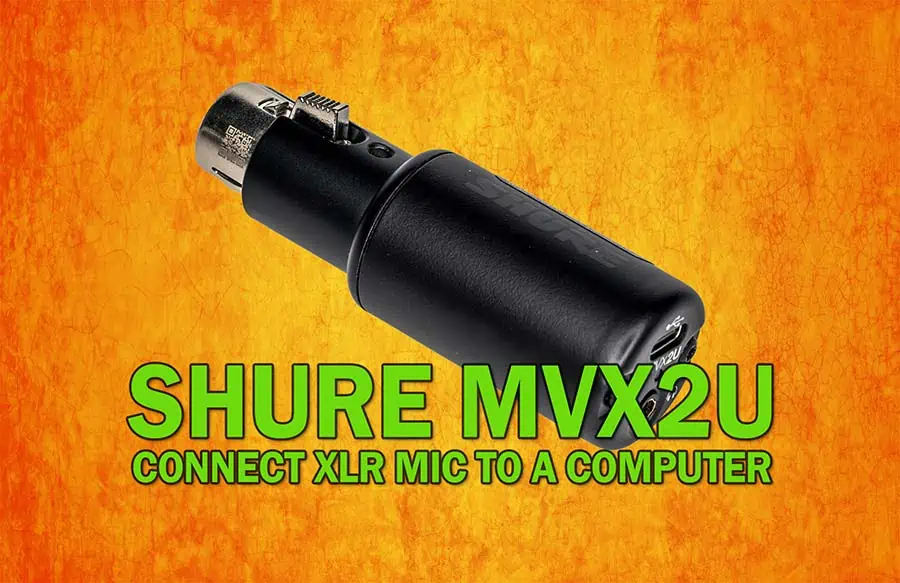Author: Tosh Lubek Posted: 27th February 2024
DIY Video Studio is supported by its readers who use the affiliate links or ads on this site. As an Amazon Associate, I earn from qualifying purchases. Thank your support if you use any of the links.
I’m Tosh Lubek. I started in audio production way back in the 1980s working in commercial radio. So, I’ve been hooking up microphones to reel-to-reel tape recorders to PCs.
Today I’m taking a deep dive into the Shure MVX2U USB adapter, a piece of gear that lets you connect an XLR microphone to computer. So, stay tuned as we begin!
- LIVESTREAM READY – XLR to USB connectivity with Auto Level Mode right out of the box
- DYNAMIC & CONDENSER MICS – Up to 60dB of Gain and 48v of Phantom Power means you can level up any…
- HEADPHONE MONITORING – Zero-latency Audio Monitoring and Playback via built-in 3.5 headphone jack
- FUTURE PROOF YOUR AUDIO SET UP – In App updates mean you never lose out on the newest features and…
Last update on 2024-03-10 / Affiliate links / Images from Amazon Product Advertising API
What’s in the box
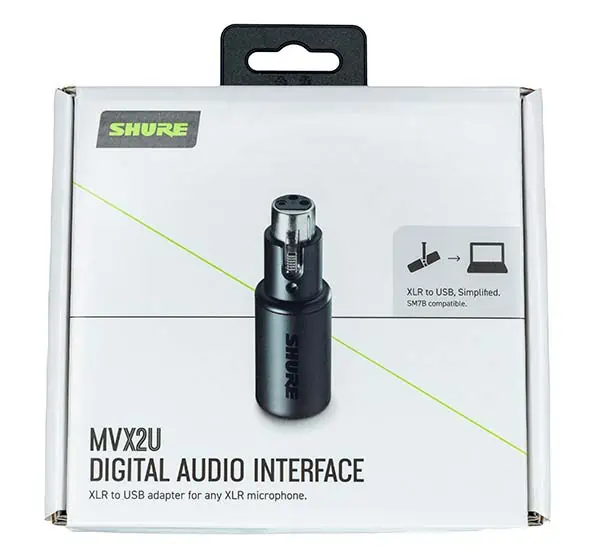
- 1x MVX2U audio interface
- 1x USB-C to USB-C cable (1m/3ft)
- 1x Quick start guide with QR code to download MVX2U User Guide
- 1x Shure Wired Microphone Owner’s Manual
What is the Shure MVX2U USB adapter
The Shure MVX2U USB Adapter is a one-channel digital audio interface for microphones with XLR connectors, allowing them to be used with a computer or mobile phone. It will fit in the palm of your hand and is all-metal. The build quality is very good, giving the impression of quality and durability.
One end has a female XLR connector that plugs into an XLR microphone or XLR audio cable. The other end features a USB-C port, a 3.5mm headphone socket for zero-latency direct monitoring, and a phantom power status LED.
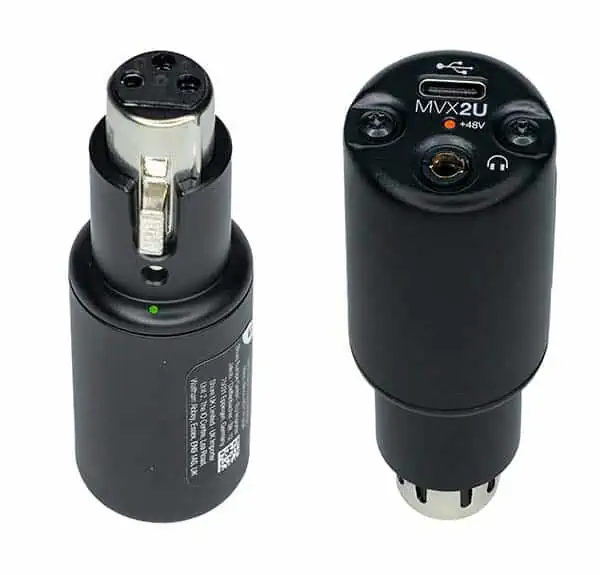
There’s a second LED on the side of the MVX2U that shows the device’s status.
- Green: Successful USB connection
- Amber: Failed USB connection
- Amber flashing: Firmware update in progress
- Red: MVX2U is muted
- Off: Not connected
There are no controls on the interface. This includes no gain control or capacitive mute button. Adjustments to the gain, audio processing, and muting of the audio are done in the free ShurePlus MOTIV desktop app. The settings will be saved to the adapter and used even if you later connect to a computer that does not have the MOTIV app installed.
Who is the Shure MVX2U for?
If you already have a good standard audio interface in a home studio or need to connect two or more XLR inputs simultaneously, the MVX2U is probably not for you.
But for podcasters, streamers, and musicians who are on the road, this portable audio interface will be useful if you want to connect an XLR microphone to a laptop or phone. The adapter’s features, convenient size, and durability make it ideal for traveling creators with limited luggage space.
So, if you need a podcast microphone adapter or a streaming microphone adapter on the go, this might be for you.
MVX2U Compatibility
The MVX2U is compatible with Windows and Mac computers. I’ve also tested it with my Samsung Android A53 5G phone. Although I can record on my phone, the ShurePlus MOTIV mobile app cannot control the settings. Hopefully, this will change in the future.
The interface is compatible with most XLR microphones since it can supply +48V phantom power and has a built-in preamp providing a gain boost of up to 60dB. So, the MVX2U would work as a Shure SM7B adapter, since the SM7b is notorious for its low output.
Headphone monitoring requires headphones with a 3.5mm TRS jack. The headphone amp provides a good output level in low-impedance headphones.
Shure MVX2U Key Features
The key features of the MVX2U include:
- +48V phantom power adapter.
- Built-in preamp providing a signal gain of up to +60dB.
- Direct headphone zero-latency monitoring for real-time feedback.
- Auto Level Mode or Manual Mode that can be set up with the ShurePlus MOTIV desktop app.
- Plugs directly into the microphone or can be added in line with an XLR audio cable.
- XLR locking button the ensure it remains securely connected.
- A sampling rate of 48kHz and bit depth of 16 or 24 bits.
- Frequency response of 20Hz to 20kHz.
- LED status indicator.
- Headphone impedance 32Ω.
Shure MVX2U setup and usage
Here’s a step-by-step guide to setting up the MVX2U. If you will always be using the adapter with the same microphone and speaking at roughly the same level, you only need to do this once by using the ShurePlus MOTIV desktop app.
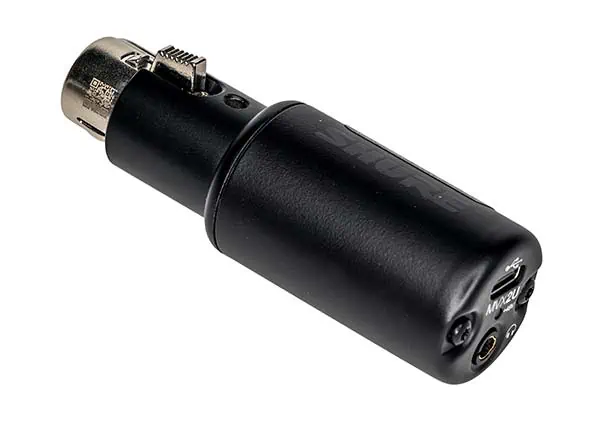
- Download the ShurePlus MOTIV Desktop app from https://www.shure.com/MOTIVdesktop
.
- Plug an XLR microphone into the MVX2U or microphone cable.
- Connect the MVX2U to a USB-C port on your computer using the supplied USB cable. The LED on the side of the MVX2U will initially glow amber before turning green to confirm the USB connection has been made.
- To monitor the audio, plug headphones into the 3.5mm monitor output socket.
- Use the MOTIV app to customize the signal processing and mic gain. If you are new to recording, Auto Level Mode will ensure the output remains constant. But you will get better results by using Manual Mode. To avoid clipping and distortion, activate the Limiter.
- Once you have customized the sound settings you can close the MOTIV app. The settings are saved to the MVX2U and used when you connect to any computer, even if it does not have the MOTIV app installed.
Note: the first time you use the adapter, phantom power will be turned on by default. Turn phantom off power in the MOTIV app before connecting a ribbon mic.
Sound Quality
With a high-output condenser mic connected to the MVX2U USB adapter, the noise floor will appear low enough not to be noticed during real-time monitoring in your headphones.
However, when you attach a low-output dynamic mic, like the Shure SM7b, you’ll need to increase the gain in the MOTIV app to between 55dB and 60dB to peak at around -12dB to -6dB. This gain increase raises the noise floor, introducing a noticeable hiss.
If you’re not striving for the best audio quality the slight hiss might not be an issue. It could be removed with Denoise plugins or eliminated by using an inline mic preamplifier with the MVX2U, allowing you to lower the gain in the MOTIV desktop app.
The trouble with this workaround is that it adds to the overall cost. But this might be ideal if you’re looking for a compact audio solution for travel.
Pros and Cons of the Shure MVX2U
| PROS | CONS |
|---|---|
| Small form factor | Mic preamp noise with low-output dynamic mics. To produce clean audio you may need an additional inline mic preamp |
| Durable all-metal build | Auto Level Mode in the MOTIV app needs improving |
| +48V phantom power adapter | |
| Windows/Mac compatible | |
| Connects to mobile devices | |
| Customizable signal processing with settings saved to the interface | |
| Can connect directly to the mic or to an XLR audio cable | |
| Locking XLR connector | |
| Up to 48kHz and 24-bit audio resolution |
MVX2U Alternatives
There are not many devices that are an exact alternative to this microphone USB adapter.
You can find much cheaper XLR to USB adapter cables that allow you to connect XLR dynamic mics to the USB port on a computer. I’ve covered these elsewhere, but the trouble is that they can’t provide phantom power and the output level is miniscule. To make them usable you will need both a phantom power supply and an inline preamp. Even then they are not equivalent to the MVX2U.
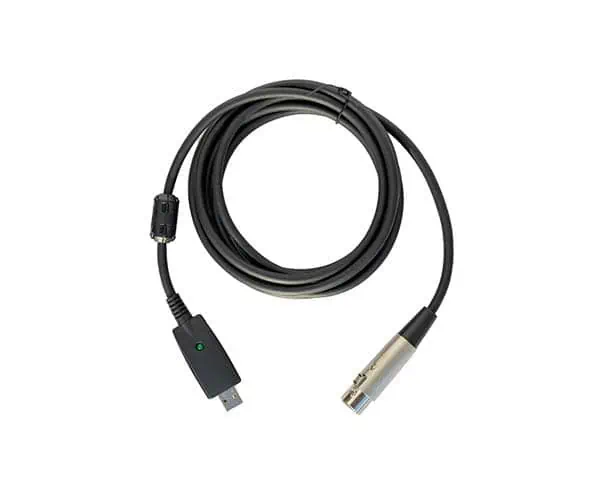
Conclusion
If you’re in a home studio there are plenty of better audio interfaces that beat the MVX2U on functionality and sound quality. But for creators who want to use XLR mics on their travels, the Shure MVX2U is small, rugged, and lets you connect dynamic and condenser mics to Windows and Mac computers as well as mobile devices. It works well with condenser microphones but if you connect a low output dynamic microphone, such as the SM7b, I would get an inline mic preamplifier to lower the noise floor.
About the author: Tosh Lubek is a multi-award-winning broadcaster, writer, and video producer, with 40 years of experience in professional broadcasting and has been using Canon video and stills cameras since 2010. He has worked with radio and TV broadcasters, advertising agencies, and direct clients on a variety of projects including radio and television advertising, online video production, corporate videos, award ceremony motion graphics, and theme park sound design. Tosh has won numerous awards, including a Radio Academy Awards Gold Sony, a Gold, Silver, and Bronze World Medals in the New York Festivals International Advertising Awards. Since about 2007 he has been creating YouTube videos. Tosh has been a sponsor of the “video booth” at HashTag Business Events across the UK.
Recent Posts
Recently, I shot several customer testimonial videos in 4K for a client when the overheating warning on my Canon EOS R6 appeared. In fact, it appeared three times in five sessions during the day of...
Why Every Photographer Should Have a Nifty-Fifty 50mm f/1.8 Lens
If there’s one lens nearly every photographer should own, it’s the 50mm f/1.8 - better known as the “nifty fifty.” This affordable lens provides impressive quality and versatility, making it...


